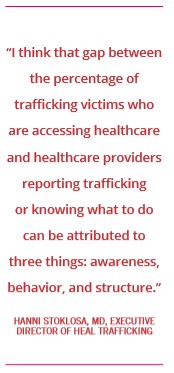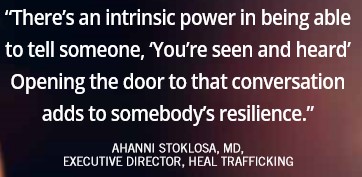As a healthcare provider in the U.S., you have likely cared for a victim of human trafficking. But if you’re like many healthcare providers, you likely weren’t aware that your patient was experiencing abuse.
If you did spot signs of human trafficking, you may not have had the opportunity to speak privately with your patient, or known how to connect them with the right support.

Human trafficking, a $150 billion global industry affecting 25 million victims around the world each year, traps people in a form of modern slavery through fraud and coercion. According to a 2018 report by Polaris, a nonprofit organization that runs the national human-trafficking hotline, and Freedom Network USA, the country’s largest anti-trafficking coalition, healthcare is one of the industries most accessed by people experiencing human trafficking, along with financial services, transportation, and short-term housing.
Polaris reports that up to 88 percent of those experiencing human trafficking interact with a healthcare provider, but only 6 percent of healthcare providers recall treating a victim of human trafficking. There are several reasons for this awareness gap, says Hanni Stoklosa, MD, executive director of HEAL (Health Education Advocacy Linkage) Trafficking, a group working to end human trafficking by impacting public policy and increasing awareness of human trafficking as a public-health issue.
“I think that gap between the percentage of trafficking victims who are accessing healthcare and healthcare providers reporting trafficking or knowing what to do can be attributed to three things: awareness, behavior, and structure,” Stoklosa says.
SEPARATING MYTH FROM FACT
First, like the general public, many healthcare providers aren’t aware of the forms human trafficking can take, or the signs that a patient might be experiencing coercion or abuse. “Trafficking is not integrated systematically into our medical education, so there are providers who have never heard of trafficking,” says Stoklosa.

Misconceptions about human trafficking are widespread, says Abigail English, JD, of the Center for Adolescent Health & the Law. English, who chairs the HEAL Trafficking Advocacy Committee, says these pervasive trafficking myths can prevent healthcare providers from recognizing victims in their care.
The term “human trafficking” is generally associated with young women born outside the U.S. being transported across borders and coerced into sexual slavery. According to research published in Obstetrics & Gynecology, fewer than half of trafficking victims are forced into sexual labor. The rest are involved in labor trafficking, in which victims are forced to perform labor in a wide range of industries including food service, carnivals, hospitality, and even healthcare.
Because reports about human trafficking tend to focus on sex trafficking cases, labor trafficking is often under-recognized. “We need to communicate that both sex and labor trafficking are important parts of the problem, both globally and here in the U.S.,” says English.
Trafficking affects people of all ages, genders, and nationalities. Although the term “trafficking” implies movement, trafficked individuals are not necessarily being transported. “People have often thought about human trafficking as something that happened somewhere else, and that trafficking victims were foreign-born,” says English. “There’s also a misperception that in order to be considered a victim of human trafficking, one had to be transported from one place to another. In fact, under the law, trafficking is not dependent on a change of location.”
The coercion tactics employed by traffickers can make victims particularly hard to recognize, because these victims may not realize that they are involved in human trafficking. “The trafficked person themselves may not realize that they’re being exploited; all of their information is being controlled by the trafficker,” Stoklosa notes. “So they may not identify with being a victim of trafficking, and they may not present in a way that the healthcare provider identifies with trafficking.”
The second factor preventing healthcare providers from recognizing victims in their care relates to human behavior. “On the behavioral side, as a physician, I am human,” Stoklosa says. “I have an unconscious bias about what a trafficking victim might look like, which is shaped by how I grew up, my age, and my race. There’s an image of a victim that comes to my mind when I hear the word trafficking. A real victim may not fit that image; in fact, because of prior trauma, they may be angry or be perceived as an aggressor, not a victim.”
Finally, the patient-flow procedures in place at many hospitals and clinics leave little time or opportunity for victimized patients to ask for help. “When a provider is in the emergency department, even if a patient fits some
of the red flags for sex trafficking or labor trafficking, the provider may not feel they have a moment of time to inquire more,” says Stoklosa. “If we don’t allow providers to have a private moment with each patient, we’re doing patients a disservice, and it’s rare that an ED has that in their flow.”
WHAT HEALTHCARE PROVIDERS NEED TO KNOW
Thanks to the efforts of groups like Polaris and HEAL Trafficking, human trafficking is increasingly being recognized as a public-health issue. “In general, there has been a growing awareness among policymakers as well as healthcare providers that human trafficking is a public-health issue, not just a criminal-justice and law enforcement issue,” says English. “This is really a welcome development, and I hope this trend will continue.”
This means that more healthcare providers will have access to training that can help them identify and support survivors of human trafficking. The SOAR Training from the US Department of Health and Human Services equips healthcare and social-service professionals to identify and treat victims of human trafficking.
Healthcare providers also need to be aware of their state’s laws related to reporting suspected abuse, notes English. “A number of states have now incorporated human trafficking into their child-abuse reporting laws, so it’s important for healthcare providers to know what the law requires them to do,” she says. “They also need to understand what services are and are not available for trafficking survivors, and what protections are available to them if they’re reported to child welfare or law enforcement under child-abuse laws.”
HEALTHCARE AND HEALING
Without the right protocols in place, even well-trained, caring healthcare providers will struggle to help trafficking victims in their care. Key changes— like updating patient-flow protocols to allow clinicians time alone with patients, routinely using interpretation services, and employing new screening tools to improve patient-provider communication—can help those experiencing human trafficking better connect with trauma-informed support.

New screening tools can increase the chances that a victim will disclose abuse to their healthcare provider, says Stoklosa. “When a person is experiencing violence or exploitation, there needs to be a framework for them to disclose if and when they’re ready,” she says. “Evidence from domestic violence shows that when you do a disclosure-based screening with a checklist, you get less disclosure than when you take a universal educational approach. People can tell when you’re ‘checkboxing’ them.”
HEAL Trafficking, in collaboration with Dignity Health, is creating that framework with the PEARR (Provide privacy, Educate, Ask, Respect and Respond) tool, a screening framework that prioritizes human connection over checkboxes. By combining privacy, education, and simple questions, PEARR empowers patients to ask for help if they choose.
Getting comfortable with certain phrases and questions helps providers make use of limited time alone with patients. “What I say is, ‘As your doctor I care about your health, and I see your health is related to your relationships and the work that you do,’” says Stoklosa. “‘A lot of my patients exchange sex for drugs and then they meet the wrong drug dealer, who starts controlling every inch of their lives. The reason I’m asking is, we have resources to help people to who get stuck in those situations.’”
Not every victim will take the opportunity to ask for help, of course. But creating pathways to safety allows more people to find their way to freedom. “There’s an intrinsic power in being able to tell someone, ‘You’re seen and heard,’” says Stoklosa. “Opening the door to that conversation adds to somebody’s resilience.”
Sources:
Hanni Stoklosa, MD, MPH, Executive Director, HEAL Trafficking (HEALtrafficking.org)
Abigail English, JD, Chair, HEAL Trafficking Advocacy Committee (HEALtrafficking.org) Director, Center for Adolescent Health & the Law (www.cahl.org)
https://www.ncbi.nlm.nih.gov/pmc/articles/ PMC5699814/
https://polarisproject.org/human-trafficking-and-thehealth-care-industr…
https://journals.lww.com/greenjournal/pages/results. aspx?txtKeywords=trafficking